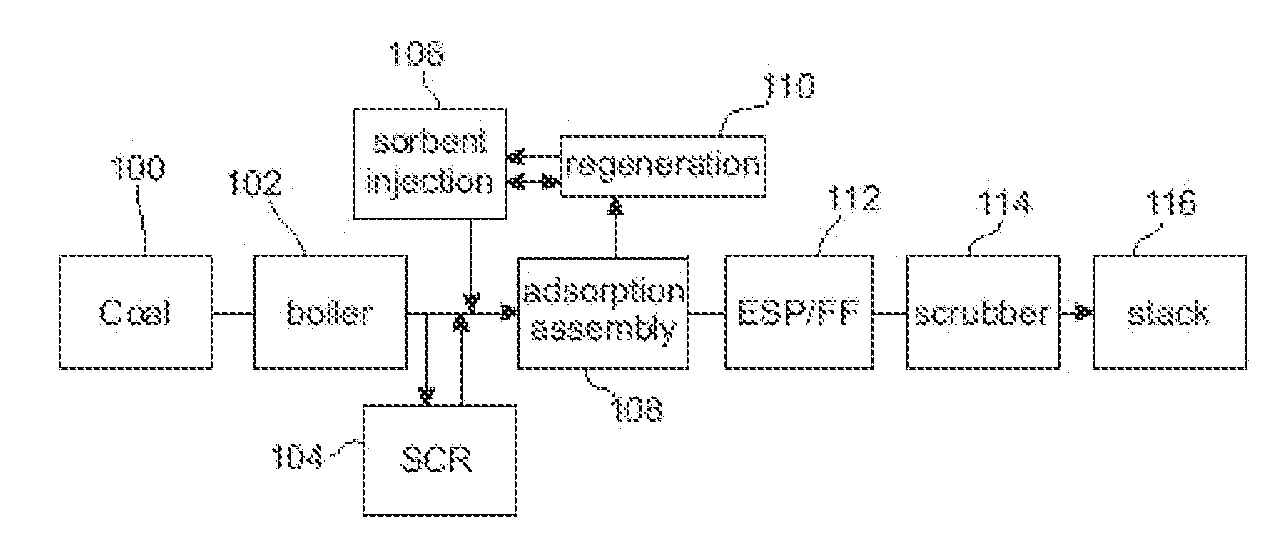Method to Remove an Agent Using a Magnetic Carrier from the Gaseous Phase of a Process
- Summary
- Abstract
- Description
- Claims
- Application Information
AI Technical Summary
Benefits of technology
Problems solved by technology
Method used
Image
Examples
example 1
[0057] A typical high surface area zeolite, MCM-41 (Mobil Technology Corp., Paulsboro, N.J.) was used to demonstrate air adsorption. This adsorbent used a synthetic zeolite support whose starting surface area was 850 m2 / g and had a surface area of 358 m2 / g after adding the adsorbent ligand, typical of the supercritical gas process. This sample was mixed in roughly equal volume proportion with glass frit and placed in a permeation tube. A mercury source that adds elemental mercury to a dry nitrogen gas stream was used to produce the test stream. The flow rate was adjusted to provide 1.3 seconds dwell time in the adsorbent bed with a elemental mercury concentration of 39 μg / m3. The concentration of mercury in the exit side of the permeation tube was monitored for 300 minutes.
example 2
Silica
[0058] A silica support was processed using the same preparation method accounting for differences in surface area. A typical high surface area silica was used to demonstrate air adsorption, Degussa Sipernat50 (Degussa Corp., Parsippany, N.J.) whose surface area is reported as 450 m2 / g. After producing this adsorbent it had a surface area of 115 m2 / g, typical of the supercritical gas process. This sample was tested the same way as the synthetic zeolite sample.
example 3
[0059] A quantity of magnetite (MNP-X-9002) (Magnox Specialty Pigments, Inc., Pulaski, Va.) was prepared the same as was used in Examples 1 and 2 taking the powder surface area into account. After processing this adsorbent with a starting surface area of 95-100 m2 / g it had a final surface area of 80-85 m2 / g, typical of the supercritical gas process. This material was processed according to the method described by Fryxell, Zemanian, et al., U.S. Pat. No. 6,531,224, and Fryxell, Zemanian, et al., U.S. Pat. No 6,753,038 (hereby specifically incorporated by reference in their entirety). This sample was tested in both as-is and dried states. In order to test different dwell times in the packed bed, the gas flow rate was increased and if necessary the bed length was shortened. The details of flow rate and concentration are shown in Table 1.
TABLE 1MercuryDwell time[Hg]input,Test time,capture, %in absorbent,Sampleμg / m3Minutes[Hg]test timeof inputsec.HS060106B, as is3730024.633.5...
PUM
 Login to View More
Login to View More Abstract
Description
Claims
Application Information
 Login to View More
Login to View More - R&D
- Intellectual Property
- Life Sciences
- Materials
- Tech Scout
- Unparalleled Data Quality
- Higher Quality Content
- 60% Fewer Hallucinations
Browse by: Latest US Patents, China's latest patents, Technical Efficacy Thesaurus, Application Domain, Technology Topic, Popular Technical Reports.
© 2025 PatSnap. All rights reserved.Legal|Privacy policy|Modern Slavery Act Transparency Statement|Sitemap|About US| Contact US: help@patsnap.com



